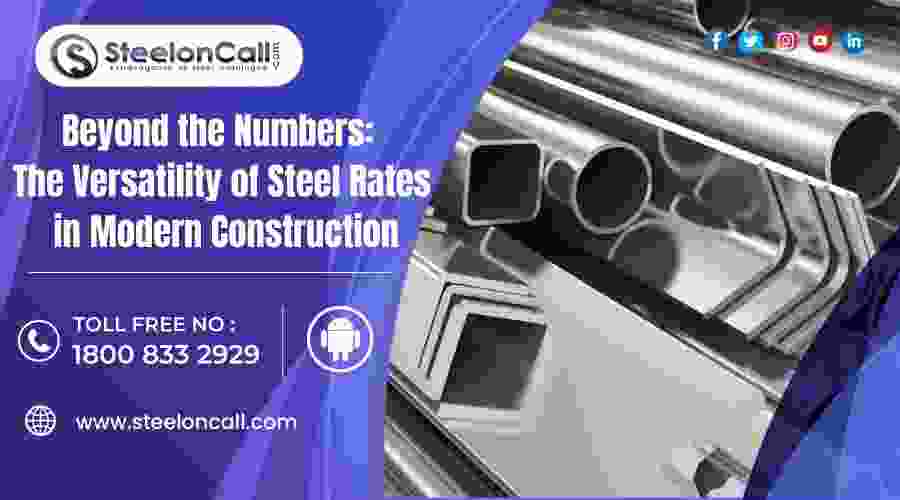Beyond the Numbers: The Versatility of Steel Rates in Modern Construction

In the ever-evolving landscape of modern construction, the significance of steel goes far beyond its numerical price tags. Although steel rates undeniably hold a pivotal role in the intricate dance of project budgeting, the inherent versatility of this material emerges as a defining force, shaping the essence of contemporary construction practices.
While financial considerations are fundamental to any construction project, focusing solely on steel rates would be a myopic perspective. With its unparalleled strength, adaptability, and durability, steel becomes an invaluable asset that extends beyond the constraints of budget sheets. Architects and engineers harness the flexibility of steel to breathe life into visionary designs, transcending traditional boundaries and ushering in a new era of architectural marvels.
1. The Foundation of Modern Structures:
Steel has long been revered for its unmatched strength-to-weight ratio, making it the backbone of modern structural engineering. Its cost-effectiveness is advantageous, and its adaptability enables architects and engineers to push design limits by creating structures that defy convention. Skyscrapers and intricate bridges have all benefited from steel's versatility as a material.
2. The Economic Landscape: Navigating Steel Rates
Steel rates take center stage in project planning as the construction industry grapples with fluctuating economic conditions. The relationship between supply and demand, global market trends, and geopolitical factors directly impact steel pricing. However, savvy builders and developers recognize that beyond the numerical fluctuations lies a material that offers unmatched durability and longevity, mitigating the short-term nuances of market rates.
3. Environmental Considerations: A Sustainable Choice
In an era where sustainability is paramount, the versatility of steel extends beyond its structural attributes. Steel is one of the most recycled materials globally, embodying the principles of a circular economy. The eco-friendly nature of steel aligns with the growing demand for sustainable construction practices, making it a choice that goes beyond its rates, contributing to a greener future.
4. Design Freedom and Flexibility:
Steel's versatility gives architects the power to explore creative designs. Unlike traditional construction materials, steel's malleability enables architects to explore inventive architecture. Moldable into complex shapes, steel creates visually pleasing yet structurally secure buildings. This flexibility speaks volumes about its strength and shows its capacity to accommodate artists' artistic visions.
5. Durability: A Long-Term Investment
While steel rates may vary, the longevity of structures built with steel remains constant. Steel's inherent durability and resistance to corrosion ensure that buildings stand the test of time, requiring minimal maintenance over the years. This longevity factor transforms the initial investment in steel into a wise, long-term decision, offering a compelling value proposition for builders and investors.
6. Innovation in Construction Techniques:
The versatility of steel extends to the methods used in its construction. Prefabrication and modular construction, made possible by steel's precision and consistency, are revolutionizing project timelines and efficiencies. Steel's uniform properties enable components to be manufactured off-site with high precision, reducing construction time and minimizing on-site disruptions.
7. Meeting Stringent Safety Standards:
Safety is non-negotiable in construction, and steel's inherent properties contribute significantly to creating secure structures. Steel-framed buildings excel in seismic zones, providing a robust solution for earthquake-prone regions. The material's fire resistance further enhances its safety profile, making it a preferred choice for projects where safety is paramount.
8. Future Trends: Advanced Alloys and Beyond
Technology continues to advance, expanding steel's versatility in construction projects. High-strength and weathering steel alloys offer enhanced performance characteristics, opening up opportunities for architects and engineers to design resilient and visually pleasing buildings.
9. Today's Steel Rate in India:
Today's steel rate in India opened at Rs 43,700.00 and is witnessing an upward trend of 0. 48%. Humans have long used steel as one of their go-to materials for manufacturing applications, remaining one of the most reliable and flexible choices available to manufacturers today.
10. Steeloncall: A reliable marketplace for quality steel
Steeloncall is a trusted marketplace steadfastly committed to providing top-tier steel quality. Renowned for its unwavering dedication to excellence, Steeloncall emerges as a reliable supplier that prioritizes delivering superior products. Whether you're engaged in construction, manufacturing, or any other industry requiring high-quality steel, Steeloncall ensures that each product meets stringent standards. The brand's emphasis on assurance and durability makes it a go-to project choice. With Steeloncall, customers can confidently navigate the diverse landscape of steel products, knowing that reliability and quality are at the forefront of every transaction.
Conclusion:
While steel rates play a central role in construction economics, it is vital to recognize steel's multifaceted nature in shaping today's construction environment. Beyond being a cost-effective material, its versatility, durability, and sustainability make it one of the cornerstones of innovation within construction practices today. Furthermore, this adaptable material ensures its relevance in changing architecture and engineering environments over time - it ensures it won't go the way of other building materials like timber.

